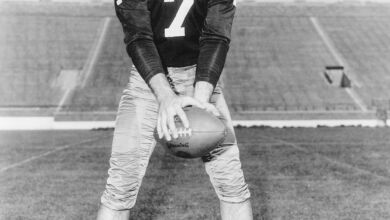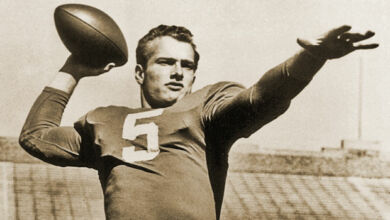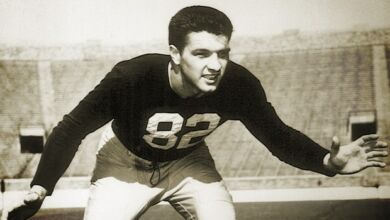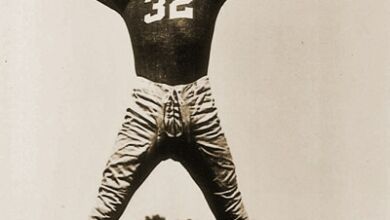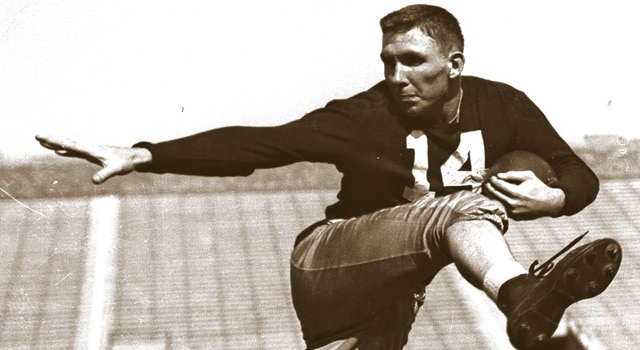
It seemed that Notre Dame’s Heisman Trophy winners were following a Westward sojourn. Angelo Bertelli, from Springfield, MA, was the first and next was John Lujack of Connellsville in Western PA. Next was Leon Hart from Turtle Creek, a Pittsburgh suburb and just northwest of Connellsville. The Fighting Irish Heisman caravan then shifted to Oak Park, a near west suburb of Chicago to Fenwick High and John Lattner. Fenwick was run by the Dominicans and was named after a Bishop Fenwick from Cincinnatti. Fenwick, which provided five recruits to Hugh Devore’s masterpiece recruiting class of 1963, became one of the lead tributaries of the Chicago Catholic League feeder system for Notre Dame along with Gordon, Brother Rice, St. Rita’s, DeLaSalle and Mt. Carmel.
While Leahy was running and prospering with the T-formation at Notre Dame, Lattner was running the single wing at Fenwick and was intrigued about playing for the Maize and Blue and running the single wing with which he was familiar.
Lattner started to get his Irish up when people chided him that he’d never play a down at Notre Dame. Remember, Lattner’s senior season at Fenwick was 1949 when Hart and the Irish were finishing the glittering 36-0-2 stretch.
“I thought I would go to one of the small Catholic colleges if I could afford it,” he said. “But by my senior year, I had all kinds of offers. I thought I was going to go to Michigan, because they ran a single wing, and Fenwick ran a single wing. It was my ideal type of offense.”
But that changed when people started telling Lattner that he shouldn’t go to Notre Dame because he “would just be a number there.” I said, “I’m going to give it a shot and see how bad I really am,'” he said. And so Lattner headed to South Bend. Lattner’s father took ill with cancer his freshman year, and passed away during spring practice. Before he died, Notre Dame quarterback John Mazur visited Lattner’s father in Chicago and promised his son would score in his first varsity game as a sophomore. Mazur was good to his word, as recounted in a Time Magazine cover story in 1953.
Lattner was 6’1 190″, not at all a “scatback.” And he was one of the most versatile halfbacks ever to play for the Fighting Irish. And Lattner had a special relationship with his head coach. Lattner could effect a beautiful brogue so rich and sweet. He used this to imitate Leahy, especially at those glorious Leahy’s lad’s reunions. Lattner had his own defining moment with Leahy.
Oct. 19, 1952 was one of those days in Notre Dame football history that Alice (in or out of Wonderland) would have described as “curiouser and curiouser” as the Irish trekked to the banks of the Wabash to play the Boilermakers. Notre Dame fumbled ten times that day, but had fewer fumbles than the Boilers, who put it on the Ross-Ade turf 11 times! Of the 21 fumbles, the Irish, who were FIGHTING, recovered 15. John Lattner, then the star junior right halfback accounted for half of the Irish fumbles, five.
Somehow, the Irish won, 26-14. Lattner was shrinking from Leahy’s steely gaze and asked permission to go back to Chicago to visit a friend of his who was ill. Leahy granted the permission but it only postponed the imnevitable lecture from Leahy. In the meantime, while Lattner was performing a Corporal Work of Mercy and visiting the sick, Leahy was working up a good lather. Somber, nearly ecclesiastical, in a story that Lattner loved to tell on himself, when Leahy did summon Lattner on his return to campus, conjuring up his own Leahyesque version of the Summa Theologica, he advised the halfback to “Get to a priest and confess those five Mortal Sins you committed against Purdue!”
Lattner Played Defense Too
Lattner was a GREAT, not a good defensive back. He was named first team All-American on both the offensive and defensive sides of the ball after the 1952 and 1953 seasons. In today’s world of unlimited substitution and “substitution packages” it is hard to grasp how extraordinary this was. Lattner’s career total of 12 is just one behind the 13 of Joe Restic and Mike Townsend who are tied for second behind Luther Bradley’s astounding total of 17. Lattner’s total is a head-shaker for a great offensive player.
Johnny Lattner Could Do Anything the Coach Needed on the Football Field
In 1951, he rushed 68 times for 341 yards, a nifty 5 yards per carry. Lattner caught 9 passed for 19.6 yards per grab, returned 9 punts for 10 yards a return and still found time to snag four interceptions.
Then, as a Junior in 1952 Lattner was the full-time starting right halfback. The backfield was strong and balanced with Neal Worden and Joe Heap. Still, Lattner led the pack with 149 carries for 734 yards. He caught 17 passes for 14.8 yards per catch. He returned 3 kickoffs and returned 7 punts for 16 yards a carry, all while intercepting 4 passes. America took notice and even though a Junior, Lattner won the coveted Maxwell award, while finishing 5th in the Heisman Trophy voting behind Billy Vessels of Oklahoma.
In 1953 the Irish were seeking a better result than the 7-2-1 of 1952, and Frank Leahy was counting on John Lattner to lead the return to glory. John Lattner did it all in th 9-0-1 (14-14 tie with Iowa) campaign. Lattner carried 134 times for 651 yards, just shy of 5 yards per carry. He caught 14 passes for 204 yards, 14.6 yards per reception. He returned 8 kickoffs for an Ismailian 40 yards per return and brought back 10 punts for a symmetrical 10 yards a return, all while intercepting his annual harvest of four interceptions Lattner was certainly adding up yardage and he outstrippled the statistical performance of all previous Notre Dame stars as he established a record for all purpose yards which stood for a quarter century until Vagas Ferguson broke it in 1979.
Did the ’53 Rule Change Help Lattner Convince the Heisman Voters?
Through the ’52 season, college football allowed unlimited substitution. But the mavens changed the rules for the ’53 season and basically made players go both ways with very limited substitution. This rule, which ran through ’63 would impact another ND Heisman winner when it was changed again. But in ’53 all the college players had their defensive deficiencies exposed when the opponent had the ball. Sort of a nice year to be an All-America defensive back, as Lattner was.
Frank Leahy’s Influential Anointing of Lattner
Lattner appeared on the cover of Time Magazine on November 9, 1953 with the caption “a bread and butter ball carrier”, a phrase bestowed upon Lattner by Leahy. Such publicity and an endorsement from the guy who’d coached 3 Heisman laureates (and had one frosh in the incubator-Hornung) were important, but the timing may have been even more import. There was no shame in Frank Leahy’s game. EVER!
The Closest Heisman Vote in History
Although Bo Jackson’s photo finish over Chuck Long in the ’85 Heisman voting later reset the closeness bar, Lattner’s victory over Minnesota Golden Gopher Paul Giel was the closest in Heisman history to that point. Lattner also repeated as the prestigious Maxwell award winner in 1953. Giel was an outstanding runner, who is considered a Gopher legend and was Big Ten Player of the Year- for the 4-4-2 Gophers. It is worth noting that Giel beat Lattner in the Midwest region, but we are not suggesting that the Big 10 journalistic lackeys had a Paul Bunyan style ax to grind with our Fighting Irish!
The Irish, despite the tie were awarded many of the national championship awards, but Maryland was chosen as champion by the AP and UPI for 1953. And most legitimate scholars consider those two the most prestigious.
It is poignant that Lattner played his last game in the last game that the incomparable Francis William Leahy ever coached at Notre Dame It was the end of an era.
GO Irish!
